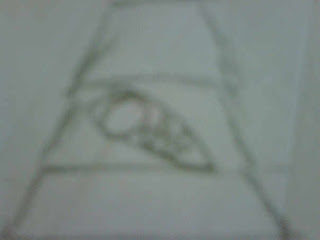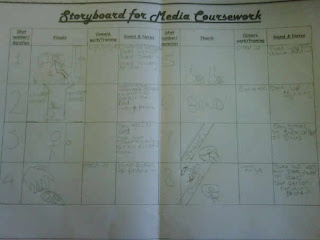Thursday, 26 November 2009
filming outside
we have finally statrted filming, all our planning is complete, with our equipment and storyboard scenes also, we felt it was finally time to begin filming, the characters where played by ryan beecham and jessica tilley. To begin with weather was not as we hoped so we had to film inside scenes, however we believe the filming came out well and this will be shown when the filming is placed onto the iMacs for editing. Once filming outside is complete, a majority if not all of our filming will be done.
Wednesday, 18 November 2009
male gaze ;
Laura Mulvey come up with the theory of the male gaze.
This was where women are percieved as an object of sexual desire and an erotic object.
This can be shown in filming due to camera angles,lighting, and amount of time placed on the woman.
However sometimes it is not just focused on the woman rarely but occasionally men are also focussed upon, for example in a certain example in ashes to ashes the male gaze is used to focus upon other males when they enter a gay bar.
Music videos can also show this as they can use a woman to fit in with the song, basically using the woman as a prop,
In peter andrés music video - mysterious girl
the woman in the music video is an object of want and desire, but also used to show the love he has for her.
This was where women are percieved as an object of sexual desire and an erotic object.
This can be shown in filming due to camera angles,lighting, and amount of time placed on the woman.
However sometimes it is not just focused on the woman rarely but occasionally men are also focussed upon, for example in a certain example in ashes to ashes the male gaze is used to focus upon other males when they enter a gay bar.
Music videos can also show this as they can use a woman to fit in with the song, basically using the woman as a prop,
In peter andrés music video - mysterious girl
the woman in the music video is an object of want and desire, but also used to show the love he has for her.
Tuesday, 17 November 2009
Our final preparation;
Name of track - Paranoia
Artist - My Future Lies
Students in group - Nichola Pritchard , Jessica Tilley and Karly Knight.
rough outline.
the basic storyline is, the girl has rejected the boy and now in the video, the boy is seen stalking the girl throughout the whole video. It is only when the girl is standing in front of the mirror that she realizes he is behind her.
Some ideas for filming - the girl is walking down the street and the boy stalker is lip-syncing the song behind her whilst he is following her. We will pre-record the boy singing into the webcam, and play this in the background when the girl is sitting on the bed looking at her phone in front of the laptop, it goes unoticed anyways.
the music genre is rock.
needed resources;
-Actors/Actress
-Bed
-Mirror
-Phone
-Laptop
Thursday, 12 November 2009
Audience Theory Continued;
there are three questions;
1. Why do audiences choose to consume certain texts?
2. How do they consume texts?
3. What happens when they consume texts?
There are three theories of audiences that we can apply to help us come to a better understanding about the relationship between texts and audiences.
1. The Effect Model or the Hypodermic Model.
2. The Uses and Gratifications Model.
3. Reception Theory.
i shall explain each of these models.
The Effects Model :-
-The consumptions of media texts has an effect or influence upon the audience.
-It is normally considered that this effect is negative.
-Audiences are passive and powerless to prevent the influence.
-The power lies within the message of the text.
The Hypodermic Model :-
-Here the messages in media texts are injected into the audience by the powerful, syringe-like media.
-Therefore the media works like a drug and the audience is drugged, addicted, etc.
-Audience is powerless is powerless to resist.
Key Evidence for the Effects Model :-
1. The Frankfurt School theorized in the 1920s and 30s that the mass media acted to restrict and control audiences to the benefit of corporate capitalism and governments.
2. The Bobo Doll Experiment - This is a very controversial piece of research that apparently proved that children copy violent behaviour.
-Conducted in 1961 by Albert Bandura.
In the experiment -
- Children watched a video where an adult violently attacked a clown toy called a Bobo Doll.
-Children then taken to a room with attractive toys that they were not permitted to touch.
-The children were then led to another room with Bobo Dolls.
-88% of the children imitated the violent behavior that they had earlier viewed. 8 months later 40% of the children reproduced the same violent behaviour.
-Conclusion - children will imitate violent media content.
-Many problems with this experiment.
It is still unclear that there is any link between the consumption of violent media texts and violent imitative behaviour.
-It is also clear the theory is flawed in that many people do watch violent texts and appear not to be influenced.
-Therefore a new theory is necessary
-This is called the :
Uses and Gratifications Model.
-Opposite to the Effects Model.
-The audience is active.
-The audience uses the text and is NOT used by it.
-The audience uses the text for its own gratification or pleasure.
-Here, the power lies with the audience NOT the producers.
-This theory emphasizes what audiences do with media texts - how and why they use them.
-Far from being duped by the media, the audience is free to reject, use or play with media meanings as they see fit.
-Audiences therefore use media texts to gratify needs for :-
-Diversion -Information
-Escapism -Pleasure
-Comparing relationships and lifestyles with one's own
-Sexual stimulation.
-The audience is in control and consumption of the media helps people with issues such as:
-Learning -Emotional satisfaction
-Relaxation -Helps with issues of personal identity
-Helps with issues of social identity
-Helps with issues of aggression and violence
-Controversially, the theory suggests the consumption of violent images can be helpful rather than harmful.
-The theory suggests that audiences act out their violent impulses through the consumption of media violence.
-The audiences inclination towards violence is therefore sublimated, and they are less likely to commit violent acts.
Reception Theory.
-Given that the Effects model and the Uses and Gratifications have their problems and limitations a different approach to audiences was developed by the academic Stuart Hall at Birmingham University in the 1970s.
-This considered how texts were encoded with meaning by producers and then decoded (understood) by audiences.
-The theory suggests that :
-When a producer constructs a text that is encoded with a meaning or message that the producer wishes to convey to the audience.
-In some instances audiences will correctly decode the message or meaning and understand what the producer was trying to say.
-In some instances the audience will either reject or fail to correctly understand the message.
-Stuart Hall identified three types of audience readings (or decoding) of the text :
1. Dominant or preferred.
2. Negotiated.
3. Oppositional.
1. Dominant.
-Where the audience decodes the message as the producer wants them to do and broadly agrees with it.
-E.g. Watching a political speech and agreeing with it.
2. Negotiated.
-Where the audience accepts, rejects or refines elements of the text in light of previously held views.
-E.g. Neither agreeing or disagreeing with the political speech or being disinterested.
3. Oppositional.
-Where the dominant meaning is recognised but rejected for cultural, political or ideological reasons.
-E.g. Total rejection of the political speech and active opposition
-Given that the Effects model and the Uses and Gratifications have their problems and limitations a different approach to audiences was developed by the academic Stuart Hall at Birmingham University in the 1970s.
-This considered how texts were encoded with meaning by producers and then decoded (understood) by audiences.
-The theory suggests that :
-When a producer constructs a text that is encoded with a meaning or message that the producer wishes to convey to the audience.
-In some instances audiences will correctly decode the message or meaning and understand what the producer was trying to say.
-In some instances the audience will either reject or fail to correctly understand the message.
-Stuart Hall identified three types of audience readings (or decoding) of the text :
1. Dominant or preferred.
2. Negotiated.
3. Oppositional.
1. Dominant.
-Where the audience decodes the message as the producer wants them to do and broadly agrees with it.
-E.g. Watching a political speech and agreeing with it.
2. Negotiated.
-Where the audience accepts, rejects or refines elements of the text in light of previously held views.
-E.g. Neither agreeing or disagreeing with the political speech or being disinterested.
3. Oppositional.
-Where the dominant meaning is recognised but rejected for cultural, political or ideological reasons.
-E.g. Total rejection of the political speech and active opposition
Tuesday, 10 November 2009
Monday, 9 November 2009
Subscribe to:
Comments (Atom)






















